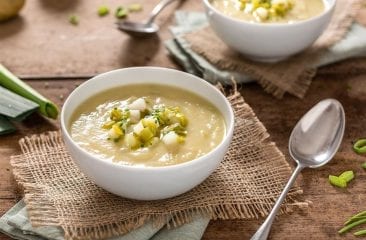Small, round and bright orange is how the popular Hokkaido pumpkin can be described. But what’s underneath its colourful surface?

It’s getting colder and the leaves are beginning to fall from the trees. The pumpkin season is here, and with it some hearty and warming recipes. The most popular of all the many types of pumpkin is undeniably the Hokkaido. It’s truly a “great pumpkin” – despite its moderate size – because its versatility makes it ideal for all kinds of dishes. But there are also some things you might not know: What parts of the aromatic Hokkaido can be used? Can you leave the skin on? When exactly is the pumpkin ripe and ready to be made into all kinds of delicacies? We’ll answer these and many other interesting questions for you in this article.
As its name suggests, the Hokkaido pumpkin doesn’t come from Europe, but from the island of the same name in northern Japan, where the locals call it uchiki kuri. Thanks to the similar climatic conditions, it has also been grown in Europe since the late 1990s and has since become one of the most popular types of autumn fruit. Yes, that’s right: the Hokkaido pumpkin is actually a berry and not a vegetable. That’s because botanists define berries as fruits whose seeds are embedded directly in the pulp. And that’s the case with pumpkins. However, because the Hokkaido is used in a similar way to botanical vegetables, it is sometimes called a fruit vegetable.
Excellent inside and out
Whether with a carved face for Halloween or as an eye-catching autumn decoration, when we think of pumpkins, the little orange Hokkaido immediately comes to mind. This popular variety weighs only one or two kilograms on average, much smaller than most other pumpkins. That’s why it is particularly popular with people who live on their own. Also characteristic is its beautiful, bright colour, which is due to the high beta-carotene content. Our bodies convert this into vitamin A, which is good for our eyesight, skin and hair. The popular squash can also be found with a dark green skin, but this variety is much less common.
What makes it so popular compared to other pumpkins is not least its firm, less fibrous flesh. This tastes mildly nutty to slightly sweet with a similar flavour to aromatic chestnuts. One of the reasons for its firm consistency is its low water content, which also gives it a much higher nutrient density. Like all other varieties, the Hokkaido has a naturally diuretic effect by stimulating kidney and bladder activity. Together with its relatively low calorie and fat content, the autumn favourite is ideal for a balanced and, above all, light diet.

Shopping and storage tips
Hokkaido pumpkins are in season from late summer into cold November. In commercial storage, they can be kept for up to a year, so in theory you can get regional pumpkins all year round. To enjoy home-grown pumpkins all year round, we recommend freezing the raw pumpkin in your Liebherr freezer compartment. To do this, cut the pumpkin into bite-sized chunks, but don’t pre-cook it, or it will be mushy after defrosting. You can then keep the pumpkin in the freezer for up to twelve months.
Here’s an excellent tip for the next time you go to the food market. Are you sometimes not sure which pumpkin to choose? Then just do the tap test. If you hear a hollow sound when you tap your fingers on the skin, you can be sure that the pumpkin is ripe.

No part goes to waste
After you’ve popped the ripe pumpkin into your shopping bag, you can get to work on it in the kitchen. But then comes the next question: do I leave the skin on or peel it? The good news is that unlike many other varieties, the peel of the Hokkaido pumpkin can be eaten, and in fact contains most of the beta-carotene. But make sure you wash the skin thoroughly with warm water, or buy an organic quality pumpkin.
How you use your Hokkaido is up to your imagination. You can make a classic pumpkin soup, pumpkin bread or even something more unusual such as delicious low-carb brownies. Hokkaido can be used in savoury and sweet dishes alike and is always tasty in both! Whatever you do, don’t throw away the seeds, because they can also be made into something delicious.
Remove the seeds from the flesh then give them a good wash. Here’s a little tip: soak them in salt water overnight to remove any pieces of pulp stubbornly sticking to them. Using your oven is a good way to get the seeds completely dry. To do this, simply line a baking tray with baking paper and let the seeds dry for 30-40 minutes at about 50 °C with the fan on. Then you can start roasting them. Heat some oil in a pan and roast the seeds, turning them continuously. Finally, you can season the delicious seeds with salt and any spice you like, such as pepper or paprika. And your protein-rich pumpkin seed snack is ready!

#pumpkin, #hokkaido, #autumn, #halloween, #orange, #fruitvegetable, #berry, #betacarotene, #pulp, #nutty, #pumpkinseeds, #pumpkinsoup, #winter, #winterveg, #wintervegetables
